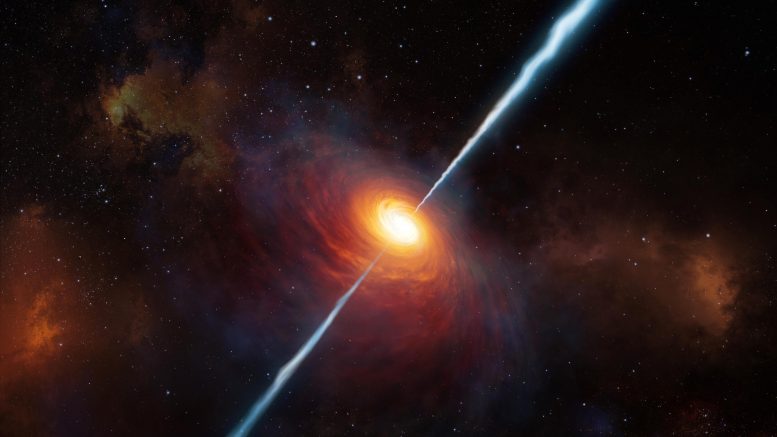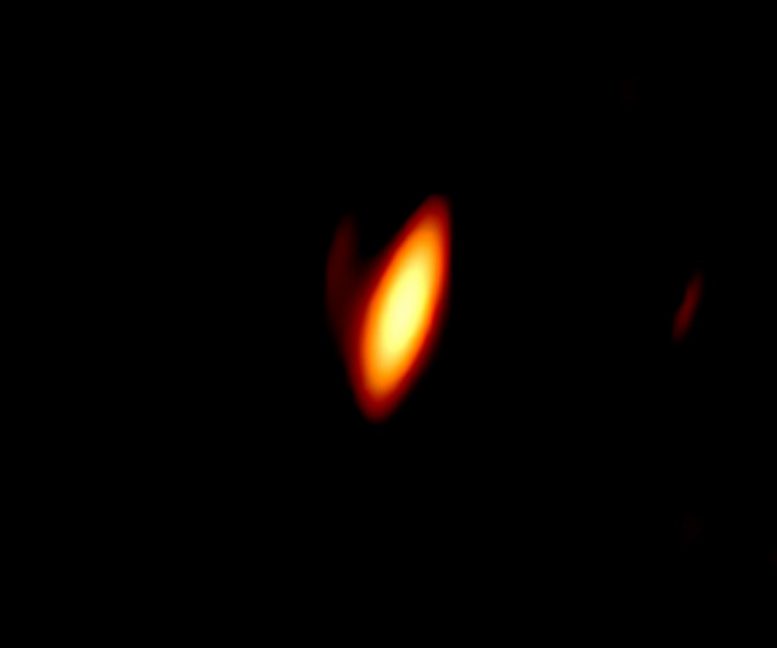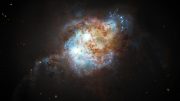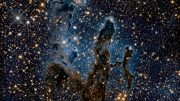
Artist’s conception of the distant quasar P172+18, with its jets of particles propelled outward at nearly the speed of light. Credit: ESO/M. Kornmesser
Quasar also can serve as ‘beacon’ for studying closer objects.
Astronomers using the National Science Foundation’s Karl G. Jansky Very Large Array (VLA) and Very Long Baseline Array (VLBA) have found and studied the most distant cosmic jet discovered so far — a jet of material propelled to nearly the speed of light by the supermassive black hole in a quasar some 13 billion light-years from Earth. The quasar is seen as it was when the universe was only 780 million years old, and is providing scientists with valuable information about how galaxies evolved and supermassive black holes grew when the universe was that young.
The studies indicate that the quasar — a galaxy harboring a black hole 300 million times more massive than the Sun — has a jet of fast-moving particles only about 1,000 years old. While other quasars have been found at its distance and beyond, it is the first found at such a distance with the strong radio emission indicating an active jet. Only a small fraction of quasars have such jets.

VLBA Image of quasar P172+18, some 13 billion light-years distant from Earth. This elongated image shows the inner part of the jet, with a size of 171 x 60 light-years. Credit: Momjian et al., NRAO/AUI/NSF
“The black holes at the cores of many of these very distant quasars are so massive that they challenge our understanding of how they could have grown in the relatively short time available to them that early in the universe’s history. One possibility is that jets provided a mechanism that allowed the black holes to grow more quickly. Finding a jet in a quasar at this epoch is an exciting clue about this question,” said Emmanuel Momjian, of the National Radio Astronomy Observatory (NRAO).
“Jets have a role in regulating star formation and the growth of their host galaxies, so this discovery is valuable to understanding these processes in the early universe,” said Chris Carilli, also of NRAO. “The jets at that time also propelled atoms and magnetic fields into what had been pristine space between the galaxies,” he added.
Finding a quasar with bright radio emission at such a distance also can help astronomers learn more about closer objects.
“Distant radio-emitting quasars at the beginning of the evolution of the cosmos also serve as beacons to study material that lies between Earth and the quasars,” said Eduardo Banados of the Max Planck Institute for Astronomy in Germany.
As radio waves pass through gas en route to Earth the gas will absorb specific wavelengths in patterns that reveal its composition.
With the help of ESO’s Very Large Telescope, astronomers have discovered and studied in detail the most distant source of radio emission known to date. The source is a “radio-loud” quasar — a bright object with powerful jets emitting at radio wavelengths — that is so far away its light has taken 13 billion years to reach us. This video summarizes the discovery. Credit: ESO
The object, called P172+18, originally was identified as a quasar candidate in 2015 in data from the Pan-STARRS sky survey using a visible-light telescope in Hawaii. The astronomers then noted that NRAO’s FIRST survey, done with the VLA, showed a radio-emitting object at the same position. They later made infrared observations that yielded the distance to the object and the mass of the black hole.
The scientists combined observations from the Magellan Baade Telescope at Las Campanas Observatory in Chile; the Nordic Optical Telescope on La Palma, Spain; the Keck telescope on Hawaii; the Very Large Telescope of the European Southern Observatory in Chile; and the Large Binocular Telescope on Mount Graham in Arizona.
The VLA and VLBA observations were made in 2019.
When quasars were first discovered in 1963 they greatly expanded the known distances in the universe. Their extreme brightness initially puzzled astronomers, but now is explained as powered by the gravitational energy of a supermassive black hole at the center of a galaxy. As material is drawn toward the black hole, it forms a disk — called an accretion disk — closely orbiting the black hole. Friction in the disk heats the material and makes it glow brightly. In some quasars, jets, such as those in P172+18, are propelled outward perpendicular to the accretion disk.
The astronomers are reporting their findings in the Astrophysical Journal and the Astronomical Journal.
Read Astronomers Have Discovered the Most Distant Source of Radio Emission Ever Known for more on this research.
The National Radio Astronomy Observatory is a facility of the National Science Foundation, operated under cooperative agreement by Associated Universities, Inc.









…As material is drawn toward the black hole…
———————————————
Black holes do not attract dust, gas, planets and people – they have different frequencies of gravity. And the surrounding gas can be ionized by a super strong quark magnetic field, which is 10 ^ 18 times stronger than the Earth’s and 10 ^ 12 times stronger than the solar.
https://www.youtube.com/watch?v=tFUM3vAlaGc
We know black holes mainly act precisely to attract nearby material to grow.
Gravity has no ‘frequencies’, how could it have – it is famous for treating all masses equal and steadily (equivalence principle).
That link is self-promoting, apparently also promoting pseudoscience.
I went far ahead.
Is that 13 billion year old black hole jet possibly out of existence now, not there anymore?
The quasars and related jet production are mostly seen in the early universe. So it appears their activity turns off eventually.
But of course the black hole and the host galaxy remains.
Quasar rays are not radiation, but the absorption of rays from the Center of the Universe, around which all galaxies revolve.
This is the northern and southern glow of black holes!
The universe has no center, we can see that space expands everywhere equally.
There is no specific “northern and southern glow of black holes” unless you refer to our idiosyncratic sky as seen due to Earth’s rotational axis. The star and so mostly correlated planet orbital and rotational axes are random outcomes (inherited from the largest gas swirl in the molecular cloud that produced the planet system).
I meant that quasars are the polar glow of black holes. Фд
How is that when we are being flung from what would be the center of the universe except there isn’t one. And we are speeding up so how are we orbiting anything. There seems to be force drawing us away from that initial big bang point from every direction. Or the exact opposite but that would mean we are the singularity being sucked into another singularity of dimensional schisms. We came from another dimension and we’re born from the stars like fireworks in a vacuum. Powered by the only thing that can transcend time and space. Love. The shiniest glowy warmy thing and idea and the only thing that can exist without being measured. Tell me im wrong. Just like they told all those other guys. That’s y u keep going down that rabbit hole never satisfied. Cuz its not an ending or a beginning it’s just a constant state of perpetual motion impartial to what is going on in whatever point in time that we fabricated to try and understand what the hell is going on. We are the universe trying to experience itself and it’s many wonders. We are exploring ourselves while doing everything else at once thru all of space and can only realize the true reason for being when we aren’t really here anymore in this state. We have to move forward to be able to grasp the bigger picture. whatever that is. Could be nothing and a disapointment. Or what we perceive as the next life is just the next phase in the forever and never. None of it matters to it because it just does what it does as we do. Forever. Die. Live. Forever. Lie. Forever. Cry. Forever. Bye. Forever. Why. Never.
Everyone will keep telling you are wrong as loing as you are wrong. The end of your mysticism comment fully disregard that science learns general facts from doing observations. And that “reason” for being is what every person makes for themselves.
But to clarify the facts we now know: the universe has no center, we can see that space expands everywhere equally by assigning the redshift we observe to galaxies – the apparent concentric shells show expansion in between galaxies. The different cosmological eras are not relative to a place in space but to time passing. Specifically, the idea that big bang preceeded inflation is out of date – the current cosmology is one of inflationary hot big bang.
“Among most people who study the early Universe, inflation is accepted as the new consensus theory. We might not know everything there is to know about inflation, but either it — or something so similar to it that we don’t have an observation to tell them apart — must have happened.”
“But if at some early time, the Universe isn’t dominated by matter or radiation, but by a form of energy inherent to space itself, you get the yellow curve. Note how this yellow curve, since it’s an exponential curve, never reaches zero in size, but only approaches it, even if you go infinitely far back in time. An inflating Universe doesn’t begin in a singularity like a matter-dominated or radiation-dominated Universe does. All we can state with certainty is that the state we call the hot Big Bang only came about after the end of inflation. It says nothing about inflation’s origins.”
“Inflation came first, and its end heralded the arrival of the Big Bang. There are still those who disagree, but they’re now nearly a full 40 years out of date. ”
[ https://www.forbes.com/sites/startswithabang/2019/10/22/what-came-first-inflation-or-the-big-bang/?sh=2f514d474153 ; Ethan Siegel is an astrophysicist]
Tlynn | March 11, 2021 at 11:50 am | Reply
The center of our universe is, and there was no Big Bang – there was and continues the Great Synthesis.
https://www.youtube.com/watch?v=tFUM3vAlaGc
And now you are also spamming the same link.
For comparison and adding more detail we have a more substantial, nearly as old jet recently described here: https://phys.org/news/2021-03-gigantic-jet-spied-black-hole.html .
“PJ352-15 breaks a couple of different astronomical records. First, the longest jet previously observed from the first billion years after the Big Bang was only about 5,000 light years in length, corresponding to the radio observations of PJ352-15. Second, PJ352-15 is about 300 million light years farther away than the most distant X-ray jet recorded before it.
“The length of this jet is significant because it means that the supermassive black hole powering it has been growing for a considerable period of time,” said co-author Eduardo Bañados of the Max Planck Institute for Astronomy (MPIA) in Heidelberg, Germany. “This result underscores how X-ray studies of distant quasars provide a critical way to study the growth of the most distant supermassive black holes.””
The diameter of our universe = 2 * 10 ^ 28 light years.
The center of our universe, which consists of strings assembled by string gravity of this diameter. exists, but we don’t see it because it’s a super black hole in the black sky that gives birth to black holes in the centers of galaxies.
I repeat the link to the video because it is not watched, and there is a translation and all the explanations.
The development of matter in the universe can be imagined with the help of rubber:
1m ^ 3 rubber weighs 1850 kg (imagine that these are strings);
1m ^ 3 tennis balls, made of the same rubber, weighs 150 kg (quarks);
1m ^ 3 soccer balls weigh 53 kg (protons and neutrons);
1m ^ 3 balloons weigh 81 g (atoms)
So, from 1 m ^ 3 rubber it is possible to make 1850: 0,081 = 22839 m ^ 3 balloons!
In the gradual transformation of matter (strings – quarks – nucleons – atoms), this ratio of volumes is even greater and differs by a number with 28 zeros!